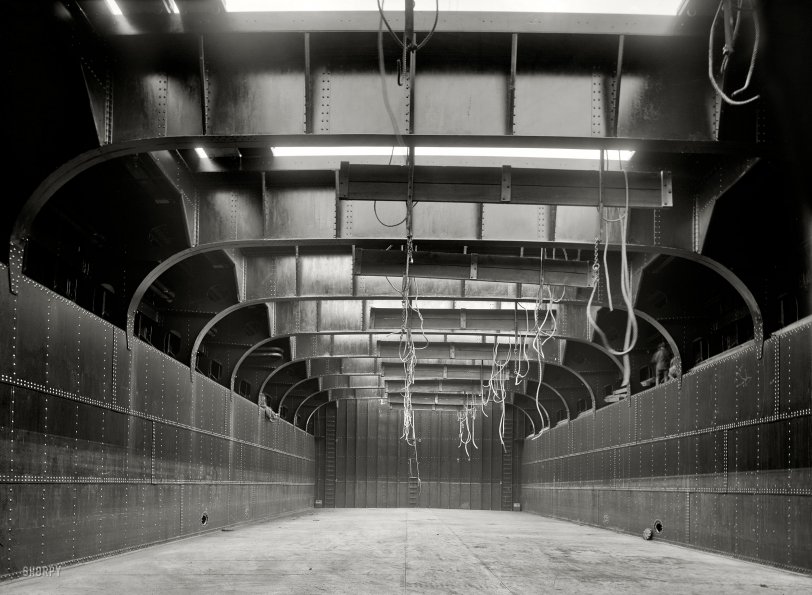


Framed or unframed, desk size to sofa size, printed by us in Arizona and Alabama since 2007. Explore now.
Shorpy is funded by you. Patreon contributors get an ad-free experience.
Learn more.

- Texas Flyer wanted
- Just a Year Too Soon
- WWII -- Replacing men with women at the railroad crossing.
- Yes, Icing
- You kids drive me nuts!
- NOT An Easy Job
- I wonder
- Just add window boxes
- Icing Platform?
- Indiana Harbor Belt abides
- Freezing haze
- Corrections (for those who care)
- C&NW at Nelson
- Fallen Flags
- A dangerous job made worse
- Water Stop
- Passenger trains have right of way over freights?
- Coal
- Never ceases to amaze me.
- Still chuggin' (in model form)
- Great shot
- Westerly Breeze
- For the men, a trapeze
- Tickled
- Sense of loneliness ...
- 2 cents
- Charm City
- What an Outrage
- Brighton Park
- Catenary Supports
Print Emporium
The Hold: 1906

Circa 1906. "Cargo hold, looking forward, S.S. J.H. Sheadle." 8x10 inch dry plate glass negative, Detroit Publishing Company. View full size.
One rm, no vu
Glad you called about that one-room apartment down by the lake. Yes, still available, and although you can't actually see the lake from it, it has some great things going for it, which I am sure you will love, such as really fabulous storage space.
Batten the hatches, and the cargo.
The long boards are called "battens." In a bulk-cargo ship, for transporting large amounts of iron ore, grain, or other cargo that doesn't come in packages, the boards are lowered and clamped together to form zones smaller than the whole hold, in cases where the hold isn't full. This can be done for several reasons: the cargo might shift when the ship rolls and pitches, or it might need to be concentrated in a particular area to keep the ship balanced level.
In a general cargo ship, battens are used to secure portions of the cargo so it doesn't shift into other parts, or (as with bulk) to keep it from moving around when the ship moves. Less-than-load and general cargo truckers use the same system if the objects being restrained are too heavy for straps and tiedowns to work.
Battens may be separately stowed timbers or, as here, suspended from the overhead of the hold so they can be placed when needed. Overhead suspension is most common in bulk-cargo ships, because the fixed position makes it easy to define particular zones where general cargo might require more random placement of the battens.
Battens may also be used in extreme weather, when the hatches leading to the hold might be pushed out of position by wind, wave, or water breaking over the deck. In that case they would be placed over the hatch(es) and "belayed" (tied down) to fittings on the deck. Thus the phrase "batten down the hatches" meaning preparation for extraordinary conditions.
Regards,
Ric
Mystery boards
A fascinating view of the vast interior storage area of a steam ship. I'm surprised both by how large it is as well the the sturdy, watertight construction.
Any riggers or stevedores who might be able to explain the function of those long boards hanging at the top of the hold? Were these used as partitions in the hold or perhaps as platforms for loading/unloading?
Bigger than a bread box.
Glad this pic had some ghost people up on top right side and left so you could get a size perspective of this place.
Coulda Been
From the Journal of Daily Fabrications; May 16, 1906:
A photographer and his enormous camera were discovered today buried under 25,000 tons of iron ore in the hold of the lake bulker SS JH Sheadle following her maiden voyage. The photographer miraculously survived the unexpected loading by huddling underneath his sturdy oak tripod and camera hood. Said victim Roland Shutters, 33, of the Detroit Publishing Company, "I think I got some good shots!" Shutters then collapsed in a humorous manner.
Just last week
I went to a Goth bar mitzvah held in a place that looked a lot like this.
























On Shorpy:
Today’s Top 5